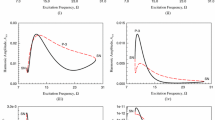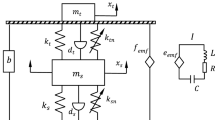Abstract
This study elucidates the bifurcation structure causing chaos disappearance in a four-segment piecewise linear Bonhoeffer–van der Pol oscillator with a diode under a weak periodic perturbation. The parameter values of this oscillator are chosen such that stable focus and stable relaxation oscillation can coexist in close proximity in the phase plane if no perturbation is applied. Chaos disappearance occurs through a previously unreported novel and unconventional bifurcation mechanism. To rigorously analyze these phenomena, the diode in this oscillator is assumed to operate as a switch. In this case, the governing equation is represented as a constraint equation, and the Poincaré map is constructed as an one-dimensional map. By analyzing the Poincaré map, we clearly demonstrate why the stable relaxation oscillation that exists when no perturbation is applied disappears via chaotic oscillation when an extremely weak perturbation is applied.


















Similar content being viewed by others
References
McKean, H.P.: Nagumo’s equation. Adv. Math. 4, 209–223 (1970)
Braaksma, B., Grasman, J.: Critical dynamics of the Bonhoeffer–van der Pol equation and its chaotic response to periodic stimulation. Physica D 68, 265–280 (1993)
Rajasekar, S., Parthasarathy, S., Lakshmanan, M. Prediction of horseshoe chaos in BVP and DVP oscillators. Chaos Solitons Fractals 2.3, 271–280 (1992)
Rabinovitch, A., Rogachevskii, I.: Threshold, excitability and isochrones in the Bonhoeffer-van der Pol system. Chaos 9, 880–886 (1999)
Rabinovitch, A., Thieberger, R., Friedman, M., Goshen, S.: Resonance effects in the Bonhoeffer–van der Pol system. Chaos Solitons Fractals 7, 1713–1719 (1996)
Rajasekar, S., Lakshmanan, M.: Period doubling route to chaos for a BVP oscillator with periodic external force. J. Theor. Biol. 133, 473–477 (1988)
Itoh, M., Tomiyasu, R.: Experimental study of the missing solutions “Canards”. IEICE Trans. E73, 848–854 (1990)
Wang, J., Feng, G.: Bifurcation and chaos in discrete-time BVP oscillator. Int. J. Non-Linear Mech. 45, 608–620 (2010)
Shimizu, K., Sekikawa, M., Inaba, N.: Mixed-mode oscillations and chaos from a simple second-order oscillator under weak periodic perturbation. Phys. Lett. A 375, 1566–1569 (2011)
Sekikawa, M., Shimizu, K., Inaba, N., Kita, H., Endo, T., Fujimoto, K., Yoshinaga, T., Aihara, K.: Sudden change from chaos to oscillation death in the Bonhoeffer–van der Pol oscillator under weak periodic perturbation. Phys. Rev. E 84, 056209 (2011)
Shimizu, K., Saito, Y., Sekikawa, M., Inaba, N.: Complex mixed-mode oscillations in a Bonhoeffer–van der Pol oscillator under weak periodic perturbation. Physica D 241, 1518–1526 (2012)
Matsumoto, T., Chua, L.O., Komuro, M.: The double scroll. IEEE Trans. Circuits Syst. 32, 797–818 (1985)
Barnes, B., Grimshaw, R.: Numerical studies of the periodically forced Bonhoeffer Van der Pol system. Int. J. Bifurc. Chaos 7, 2653–2689 (1997)
Nomura, T., Sato, S., Doi, S., Segundo, J.P., Stiber, M.D.: A Bonhoeffer–van der Pol oscillator model of locked and non-locked behaviors of living pacemaker neurons. Biol. Cybern. 69, 429–437 (1993)
Sato, S., Doi, S.: Response characteristics of the BVP neuron model to periodic pulse inputs. Math. Biosci. 112, 243–259 (1992)
Nomura, T., Sato, S., Doi, S., Segundo, J.P., Stiber, M.D.: Global bifurcation structure of a Bonhoeffer–van der Pol oscillator driven by periodic pulse trains. Biol. Cybernet. 72, 55–67 (1994)
Doi, S., Sato, S.: The global bifurcation structure of the BVP neuronal model driven by periodic pulse trains. Math. Biosci. 125, 229–250 (1995)
Tonnelier, A.: McKean caricature of the FitzHugh–Nagumo model: traveling pulses in a discrete diffusive medium. Phys. Rev. E 67, 036105 (2003)
Flores, G.: Stability analysis for the slow traveling pulse of the FitzHugh–Nagumo system. SIAM J. Math. Anal. 22, 392–399 (2006)
Gong, P.L., Xu, J.X.: Global dynamics and stochastic resonance of the forced FitzHugh–Nagumo neuron. Phys. Rev. E 63, 031906 (2001)
Buric, N., Todorovic, D.: Dynamics of FitzHugh–Nagumo excitable systems with delayed coupling. Phys. Rev. E 67, 066222 (2003)
Elmer, C.E., Vleck, E.S.V.: Spatially discrete FitzHugh–Nagumo equations. SIAM J. Appl. Math. 65, 1153–1174 (2005)
Barland, S., Piro, O., Giudici, M., Tredicce, J.R., Balle, S.: Experimental evidence of van der Pol–FitzHugh–Nagumo dynamics in semiconductor optical amplifiers. Phys. Rev. E 68, 036209 (2003)
Malevanets, A., Kapral, R.: Microscoic model FitzHugh–Nagumo dynamics. Phys. Rev. E 55, 5657–5670 (1977)
Shinohara, Y., Kanamaru, T., Suzuki, H., Horita, T., Aihara, K.: Array-enhanced coherence resonance and forced dynamics in coupled FitzHugh–Nagumo neurons with noise. Phys. Rev. E 65, 051906 (2002)
Tanabe, S., Pakdaman, K.: Dynamics of moments of FitzHugh–Nagumo neuronal models and stochastic bifurcations. Phys. Rev. E 63, 031911 (2001)
Lindner, B., Geier, L.S.: Analytical approach to the stochastic FitzHugh–Nagumo system and coherence resonance. Phys. Rev. E 60, 7270–7276 (1999)
Sekikawa, M., Inaba, N., Tsubouchi, T.: Chaos via duck solution breakdown in a piecewise linear van der Pol oscillator driven by an extremely small periodic perturbation. Physica D 194, 227–249 (2004)
Inaba, N., Nishio, Y., Endo, T.: Chaos via torus breakdown from a four-dimensional autonomous oscillator with two diodes. Physica D 240, 903–912 (2011)
Sekikawa, M., Inaba, N., Tsubouchi, T., Aihara, K.: Analysis of torus breakdown into chaos in a constrained Duffing van der Pol oscillator. Int. J. Bifurc. Chaos 18, 1051–1068 (2008)
Kaznelson, Y.: Sigma-finite invariant measures from smooth mapping of the circle. J. Anal. Math. 31, 1–8 (1977)
Ostlund, S., Rand, D., Sethana, J., Siggia, E.: Universal properties of transition from quasi-periodicity to chaos in dissipative systems. Physica D 8, 303–342 (1983)
Kaneko, K.: Supercritical behavior of disordered orbits of a circle map. Prog. Theor. Phys. 72, 1089–1103 (1984)
Arima, N., Okazaki, H., Nakano, H.: A generation mechanism of canards in a piecewise linear system. IEICE Trans. Fundamentals Electron. Commun. Comput. E80–A, 447–453 (1997)
Simpson, D.J.W., Kuske, R.: Mixed-mode oscillations in a stochastic piecewise-linear system. Physica D 240, 1189–1198 (2011)
Rotstein, H.G., Coombes, S., Gheorghe, A.-M.: Canard-like explosion of limit cycles in two-dimensional piecewise-linear models of FitzHugh–Nagumo type. SIAM J. Appl. Dyn. Syst. 11, 135–180 (2012)
Author information
Authors and Affiliations
Corresponding author
Appendix
Appendix
Here, we show that similar bifurcation structures demonstrated in the piecewise linear BVP oscillator under weak perturbation can be observed in a smooth BVP circuit; the governing equation of which is given by Eq. (1). This smooth model has been extensively studied.
We set
and illustrate one-parameter bifurcation diagrams. To illustrate these diagrams, we define a novel Poincaré map \(T_1\) as follows:
where \(\varphi (\tau ;\ (x_0,y_0)^{\top })=(x(\tau ), y({\tau }))^{\top }\) is a solution where the initial condition is \(\Big (\tau _0,x_0,y_0\Big )=\Big (\frac{2\pi \theta _0}{\omega },x\Big (\frac{2\pi \theta _0}{\omega }\Big ), y\Big (\frac{2\pi \theta _0}{\omega }\Big )\Big )\). \(\theta _0\) is real, which is introduced to simplify the discussion.
Figure 19a, b shows one-parameter bifurcation diagrams for \(\omega =1.35\) and \(\omega =0.3\) on the Poincaré map represented by Eq. (15), respectively, where \(\theta _0=0.9\). Chaos disappearance is observed at \(B_1\simeq 0.00255\cdots \equiv B_{D1-\mathrm{smooth}}\) for \(\omega =1.35\), and at \(B_1\simeq 0.00101\cdots \equiv B_{D2-\mathrm{smooth}}\) for \(\omega =0.3\). In these figures, the initial point \((x_0,y_0)\) of the one-parameter bifurcation diagrams when \(B_1=0\) is chosen such that \(\dot{x}=0\ (x>0)\), i.e., \((x_0,y_0)=(1.128960834752346,0.309959180011088)\). The initial point is chosen at a location on the stable relaxation oscillation path in the absence of perturbation. Note that chaos disappearance occurs in the case \(\omega =1.35\) even if \(B_1=0.0024<B_{D1-\mathrm{smooth}}\) with \((\tau _0,x_0,y_0)= (2\pi \theta _0/\omega ,1.128960834752346,0.309959180011088)\) for \(\theta _0=0.9\) as shown in Fig. 20, which is similar to chaos disappearance observed in the piecewise linear case, as presented in Fig. 9. In contrast, such chaos disappearance does not occur for \(B_{1}<B_{D2-\mathrm{smooth}}\) with \(\omega =0.3\) in the smooth case as far as the numerical results are concerned. Thus, the two distinctive routes to chaos disappearance are observed in the smooth dynamics of (1).
We can easily find chaos disappearance observed for \(B_1<B_{D1-\mathrm{smooth}}\) in case \(\omega =1.35\) presented in Fig. 20 by illustrating the special one-parameter bifurcation diagrams with changing \(\theta _0\) in which the initial point is reset to a point on the stable relaxation oscillation path when no perturbation is applied, i.e., \((x_0,y_0)=(1.128960834752346,0.309959180011088)\) for every increasing bifurcation parameter \(B_1\). In such special diagrams, the bifurcation structure is changed depending on the value of \(\theta _0\). Changing \(\theta _0\) changes the bifurcation parameter \(B_1\) at which chaos disappears. The special one-parameter bifurcation diagrams are presented in Fig. 21. In contrast, the shape of these diagrams for \(\omega =0.3\) do not depend on \(\theta _0\), and they appear to be always the same as that in Fig. 19b.
Rights and permissions
About this article
Cite this article
Inaba, N., Sekikawa, M. Chaos disappearance in a piecewise linear Bonhoeffer–van der Pol dynamics with a bistability of stable focus and stable relaxation oscillation under weak periodic perturbation. Nonlinear Dyn 76, 1711–1723 (2014). https://doi.org/10.1007/s11071-014-1240-5
Received:
Accepted:
Published:
Issue Date:
DOI: https://doi.org/10.1007/s11071-014-1240-5







